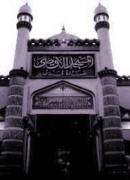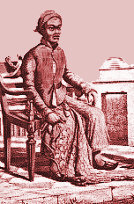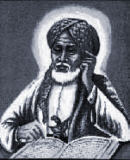The nine walis were Sufi teachers who spread Islam and did all variety of powerful and unusual acts across Java. The histories of these men are not always clear. In fact, if you try to count all of them, you will end up with more than nine. Some sources say that there was more than one group of nine. The most probable explanation is that there was a loose council of nine religious leaders, and that as older members retired or passed away, new members were brought into this council.
Symbolically, for later rulers on Java, the wali songo provided a link between the rulers of Majapahit or earlier kingdoms, and the rulers of Mataram, and eventually the Sultans of Yogya and Surakarta. They were both links in the dynastic family trees and cultural links, as they adapted the old arts and traditions to the new Islamic reality.
In spite of the confusion, and some of the legends told about them, these were real men, and some of them such as Gunungjati or Kalijogo were important figures who helped create the Java--and the Indonesia--that we know today.
Here is an incomplete (or maybe too complete!) list of the Wali Songo. Most of them did their work in the late 1400s to mid-1500s C.E.:
Sunan Gunungjati worked at Demak and Banten, and was the founder of Cirebon. Many stories say that he was originally from Pasai in Aceh, others say that he was from Pajajaran in West Java. He married the sister of Sultan Trenggono of Demak, and led military expeditions for Demak against Banten (which was still Hindu at that time). As "Fatahillah" he defeated the Portuguese when they tried to take Sunda Kelapa (now Jakarta) in 1527.
Some stories have Sunan Gunungjati active around the 1470s and 1480s, under the name "Hidayatullah", other stories have him active around the 1520s, and associate him with the name "Fatahillah". In the 1480s he would have been the grandson of the king of Pajajaran; in the late 1520s he would have fought the Portuguese near what is today Jakarta. The problem is that some stories say that he passed away in 1568, by which time he would have been as old as 120 years! Some scholars think that there may have been more than one Gunungjati.

Sunan Kudus, (or Ja'far Shadiq), founder of Kudus, who is said to have originated the wayang golek, and who founded the masjid at Kudus using (it is said) the doors from the palace of Majapahit. Took the place of his father, Sunan Ngudung. He passed away in 1550.
Sunan Kudus has also been called by the name Ja'far Shadiq, or Ja'far as-Sadiq, which was also the name of a famous religious figure in Iran, the 6th of the 12th Imams in Shi'ah Islam. Interestingly, in the city of Kudus today, there is an event called Buka Luwur, when the citizens change the curtains around the tomb of Sunan Kudus, among other things. This event is held on the 10th of Muharram of the Islamic calendar --the same day that Shi'ah Muslims remember the martyrdom of Husayn, a major date in the calendar for them. Perhaps these are reminders of the time when travelers from Iran and India made frequent trips to the north coast of Java, and had a lasting influence on the culture there.
Sunan Giri, (or Raden Paku), studied at Melaka, founded Islamic schools at Gresik, foretold the rise of Mataram, and spread Islam to Lombok, Sulawesi, and Maluku. He was a proponent of orthodox Islam, and disapproved of innovation (much like "modernist" Islamic scholars of the 1800s and 1900s). A traditional story says that he was the son of a Hindu princess of Balambangan and Maulana Ishaq of Melaka, who had gone to Balambangan as a missionary. The princess was forced to abandon him in a crisis and set him adrift on the ocean in a small boat, from which he was rescued by sailors. He was later a student of Sunan Ampel, and married the daughter of Sunan Ampel.
Sunan Giri II (or Sunan Delem)
Pangeran Sarif worked under Sunan Giri, and worked to convert the people of Madura.
Sunan Prapen

Sunan Kalijogo, (also Raden Sahid), was active at Demak, student of Sunan Bonang, advisor to Senopati, father to Sunan Muria. He revived the Garebeg procession, added Islamic stories to the wayang kulit repertory, and promoted the use of traditional rituals in a new Islamic context. The IAIN (Islamic Institute) in Yogyakarta today is named after him. At times Sunan Kalijogo has been called a proponent of innovation ("innovation" in orthodox Islam is generally considered not proper).
Stories of Kalijogo also follow confused chrnologies. Some have him participating in the construction of the Masjid at Demak in the 1470s; others have him active in the mid-1500s.
Sunan Bonang, son of Sunan Ampel, wrote a popular book on theology and good behavior for Muslims. As a young man he studied with Sunan Giri in Melaka. He helped build the great masjid at Demak. A story says that he converted the later Sunan Kalijogo to Islam. He is buried at Tuban.
Sunan Muria, (or Raden Umar Said), son of Kalijogo, after whom Mount Muria is named, and who used gamelan and theatre to help promote his missionary activity. He preferred to work with common people and in isolated villages.
Sunan Maulana Malik Ibrahim (also Syeikh Maghribi) was an Arab who arrived in Java in 1404 and worked at Gresik and Leran until his death in 1419. He founded the first Islamic school or pesantren on Java. Cousin of Sunan Ampel. His work was carried out before the time period normally associated with the wali songo, making him a kind of pioneer for missionary activity on Java.

Sunan Ampel (also Raden Rakhmat) who did his work in Surabaya, and spread Islam in East Java. Sunan Ampel was the original leader of the walisongo. He was a nephew of the King of Majapahit, and a cousin to Raden Patah, first Sultan of Demak. He was actually born in Champa, an Islamic kingdom located where the southern part of Vietnam is today. Sunan Bonang and Sunan Drajad were both his sons. Sunan Giri lived with him alongside his sons as a young man.
Sunan Drajad was a son of Sunan Ampel. He built the masjid at Paciran (north of Surabaya) in 1502, and is known for promoting social and charitable works. He also promoted the use of the gamelan orchestra.
Sunan Sendang worked at Paciran until 1585.
Sunan Ngudung (or Pengulu Rahmatullah) who did his work in Matahun, and died in battle against the Hindu remnants of Majapahit in 1513. He was the father of Sunan Kudus.
Raden Hamzah (or Sunan Lamongan) who did his work in Lamongan.
Maulana Ibrahim Asmoro was the father of Sunan Ampel. He is buried at Palang near Tuban. He was married to a princess of Champa, in what is now Vietnam, and may have originally been from Central Asia.
Sunan Bayat who did his work around Tembayat, near Yogya. He was a student of Sunan Kalijogo.
Sunan Bejagung who did his work near Tuban.
Syekh Sitti Jenar (also Syekh Lemah Abang) who was sentenced to death for his strong religious convictions, which were considered by some to be heretical.
Raden Patah, founder of Demak, is sometimes included in the list. Raden Patah was the son of Kertanegara by a Chinese princess, and was brought up by Aria Damar, his half-brother, who had been sent to oversee Palembang with the title of Adipati, and was said to be a Muslim in secret. He consulted closely with Sunan Ampel before continuing on to found the city and power of Demak. Raden Patah is a "link" between the line of the old Javanese kings (such as Airlangga or Hayam Wuruk), the later Sultans of Mataram (such as Agung), and the present-day Sultan of Yogya and Susuhunan of Surakarta.
Sabtu, 29 Januari 2011
sejarah indonesia(majapahit|)
Posted by dhika bento fals on 22.06. sejarah - No comments

0 komentar:
Posting Komentar